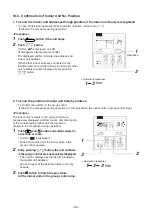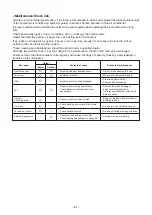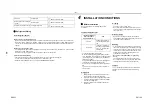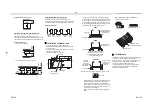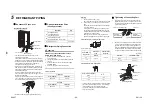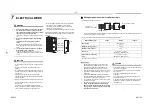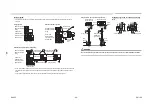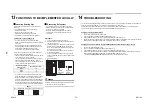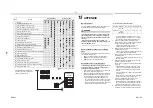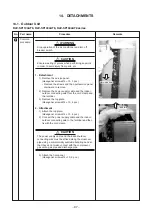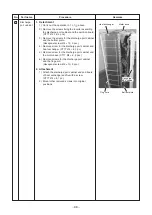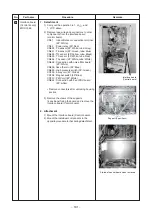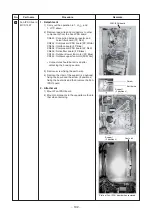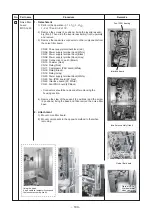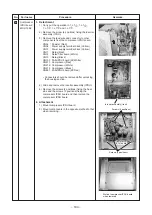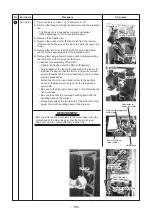
– 94 –
- 70 -
13
FUNCTIONS TO BE IMPLEMENTED LOCALLY
Handling Existing Pipe
When using the existing pipe, carefully check for the
following:
• Wall thickness (within the specified range)
• Scratches and dents
• Water, oil, dirt, or dust in the pipe
• Flare looseness and leakage from welds
• Deterioration of copper pipe and heat insulator
Cautions for using existing pipe
• Do not reuse a flare nut to prevent gas leaks.
Replace it with the supplied flare nut and then process
it to a flare.
• Blow nitrogen gas or use an appropriate means to
keep the inside of the pipe clean. If discolored oil or
much residue is discharged, wash the pipe.
• Check welds, if any, on the pipe for gas leaks.
When the pipe corresponds to any of the following, do
not use it. Install a new pipe instead.
• The pipe has been opened (disconnected from indoor
unit or outdoor unit) for a long period.
• The pipe has been connected to an outdoor unit that
does not use refrigerant R22, R410A or R407C.
• The existing pipe must have a wall thickness equal to
or larger than the following thicknesses.
• Do not use any pipe with a wall thickness less than
these thicknesses due to insufficient pressure capacity.
• When using a Ø19.1 mm gas pipe for the existing
piping, set bit 3 of SW802 (switch for existing pipe) on
the P.C. board of the outdoor unit to ON. In this case,
the heating performance may be reduced depending
on the outside air temperature and room temperature.
Recovering Refrigerant
• Use refrigerant recovery switch SW801 on the P.C.
board of the outdoor unit to recover refrigerant when
the indoor or outdoor unit is moved.
• Before recovering the refrigerant in the existing
system, perform a cooling operation for at least
30 minutes.
Procedure
1.
Turn on the power of the air conditioner.
2.
Select the FAN mode for indoor unit operation with
the remote controller.
3.
Set SW804 on the P.C. board of the outdoor unit to
all OFF, and then press SW801 for 1 second or
more. The air conditioner enters the forced cooling
mode for up to 10 minutes.
Operate or handle the valve to recover refrigerant
during this time period.
4.
Upon completion of refrigerant recovery, close the
valve and press SW801 for at least 1 second to stop
operation.
5.
Turn off the power.
DANGER
Be careful of electric shock because the P.C. board has
an electrical current running through it.
Reference outside
diameter (mm)
Wall thickness (mm)
Ø9.5
0.8
Ø15.9
1.0
Ø19.0
1.0
SW802
When shipped from factory
When using existing pipe
1 2 3 4
ON
1 2 3 4
ON
SW800 SW80
1
SW806
SW80
2
SW80
3
ON
1
2
3
4
ON
1
2
3
4
SW80
4
SW805
ON
1
2
3
4
ON
1
2
3
4
Refrigerant
recovery
switch SW801
Existing
pipe switch
SW802
14
TROUBLESHOOTING
You can perform fault diagnosis of the outdoor unit with the LEDs on the P.C. board of the outdoor unit in addition to
using the check codes displayed on the wired remote controller of the indoor unit.
Use the LEDs and check codes for various checks. Details of the check codes displayed on the wired remote
controller of the indoor unit are described in the Installation Manual of the indoor unit.
Verifying current abnormal status
1.
Check that DIP switch SW803 is set to OFF.
2.
Jot down the states of LED800 to LED804. (Display mode 1)
3.
Press SW800 for at least 1 second. The LED status changes to display mode 2.
4.
Check the code whose display mode 1 equals the LED states jotted down and display mode 2 equals the current
flashing status of LED800 to LED804 from the following table to identify the cause.
Verifying an abnormal state in the past although the abnormal state no longer occurs
1.
Set bit 1 of DIP switch SW803 to ON.
2.
Jot down the states of LED800 to LED804. (Display mode 1)
3.
Press SW800 for at least 1 second. The LED status changes to display mode 2.
4.
Find an error whose display mode 1 equals the LED states jotted down and display mode 2 equals the current
flashing states of LED800 to LED804 from the following table to identify the error.
• An outside
air temperature (TO) sensor error
can be checked only while it occurs.
EN-139
EN-140

